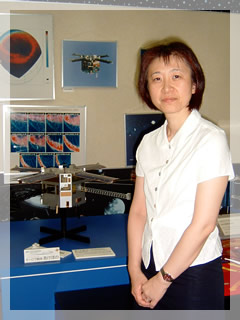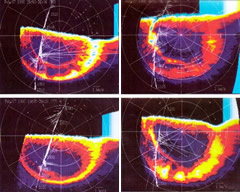|
"Akebono" (EXOS-D) was launched by the M-3SII-4 Launch Vehicle on February 22, 1989. Since then, it has been carrying out observations on space around the Earth. There are layers around the Earth called the ionosphere, which is made up of ionized atmosphere, and the magnetosphere, which is under the force of the Earth's magnetic fields. Many phenomena are occurring in these areas. The ionized gasses (plasmas) that come from the Sun are controlled by the magnetic fields. One of these atmospheric phenomena is the aurora, which is seen at arctic and antarctic areas. The primary purpose of launching "Akebono" was to investigate the aurora phenomena. "Akebono" made many discoveries in respect of plasmas which cause aurora and this led to many new questions about aurora at the same time. Several projects have followed aiming at a new era of aurora phenomena investigation like the "Reimei" (INDEX) satellite. Other than aurora, "Akebono" also made significant observation results including plasmas flowing out of the Earth, the Van Allen Radiation Belt that is harmful to living creatures and artificial satellites, and the plasmasphere, where the dense plasmas accumulate. "Akebono" has been exposed to the Van Allen Radiation Belt, a very harsh environment for a satellite, for about 20 years. No other satellite has been strong enough to continue operations under such tough conditions. The main reason for this is the tough design of "Akebono," which can't easily be damaged, even from exposure to radiation. We turn off some observation equipments before entering the Van Allen Radiation Belt, as it will affect their performance. "Akebono" enters the Van Allen Radiation Belt about every three hours during its orbital cycle. Thus the observation equipments are frequently turned on and off as part of its regular operations. The Sun looks like it shines on the Earth in the same manner all the time, but its behavior is changing in an 11-year cycle. The number of sunspots on the surface of the Sun that indicate its activeness increases or decreases in an 11-year cycle. This is strongly related to the direction of the major magnetic fields of the Sun that are reversing in a 22-year cycle. It has been revealed that the state of the aurora and the Van Allen Radiation Belt, on which "Akebono" is making observations, largely depends on the degree of the Sun's activeness. Only long-term observations like this enables such findings. The year 1989 when "Akebono" was launched was the most active period for the Sun. "Akebono" is still performing its operations with the aim of observing the plasma environment around the Earth over 22 years, the same cycle period as the Sun's magnetic fields. The day we can obtain observation data on all aspects of the Sun's activities is not that far away. (July 4, 2008 Updated.) |

Project managerAyako MatsuokaThe aurora captured by "Akebono". |
|---|
